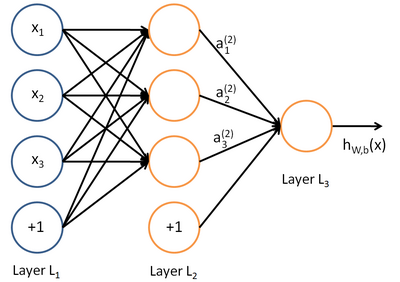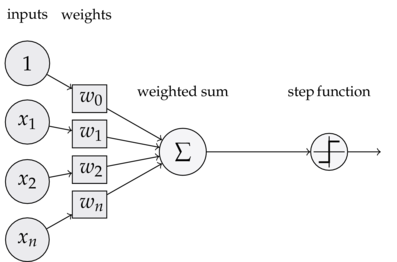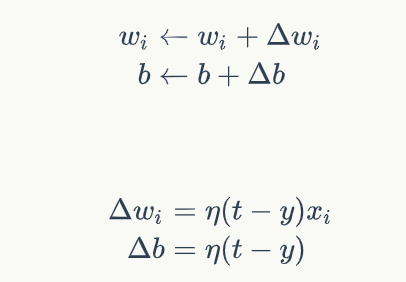【讀書報告--01】神經網路基礎學習
阿新 • • 發佈:2018-12-17
一、感知器
1.神經網路和感知器
神經網路結構包含輸入層、隱藏層(可以有多層)、輸出層,如下圖所示

其中每個神經元是一個感知器,感知器的結構組成部分:輸入權值、啟用函式、輸出
ps:啟用函式可以有很多種選擇,而感知器的輸出由 y=f(w*x+b)來計算
感知器結構如下圖:

2.感知器的訓練:(個人覺得是神經網路的重點,通過已有的資料,對權值W的相關計算)
感知器的迭代公式:

3.實戰:通過感知器實現and函式
訓練資料輸入:[1,1]->1 [1,0]->0 [0,1]->0 [0,0]->0
啟用函式:使用階躍函式
輸出:y=f(w*x+b)
程式碼如下:
from functools import reduce
class Perception(object):
def __init__(self,input_num,activator):
self.activator=activator
self.weight=[0.0 for _ in range(input_num)]
print(self.weight)
self.bias=0.0
def __str__(self):
return "weights:{0},bias:{1}".format(list(self.weight),self.bias)
def predict(self,input_X):
return self.activator(
reduce(lambda a,b:a+b,
map(lambda x,w:x*w,input_X,self.weight),0.0)+self.bias
)
def train(self,iteration,input_X,Label,rate):
for i in range(iteration):
self.one_interation(input_X,Label,rate)
def one_interation(self,input_X,Label,rate):
samples=zip(input_X,Label)
for (a,b) in samples:
y_temp=self.predict(a)
self.update_weight(a,b,rate,y_temp)
def update_weight(self,input_X,Label,rate,y_temp):
delta=Label-y_temp
self.weight=list(map(lambda x,w:w+rate*delta*x,input_X,self.weight))
self.bias+=rate*delta
def f(x):
return 1 if x>0 else 0
def get_train_dataset():
input_X=[[1,1],[0,0],[1,0],[0,1]]
Label=[1,0,0,0]
return input_X,Label
def train_and_perception():
p=Perception(2,f)
input_X,Label=get_train_dataset()
p.train(10,input_X,Label,0.1)
return p
if __name__=='__main__':
perception=train_and_perception()
print(perception)
print(perception.predict([1,1]))
print(perception.predict([1,0]))
print(perception.predict([0,1]))
print(perception.predict([0,0]))
